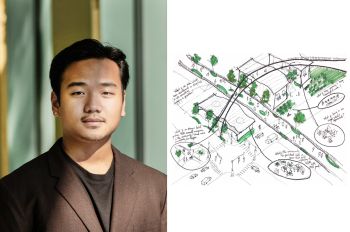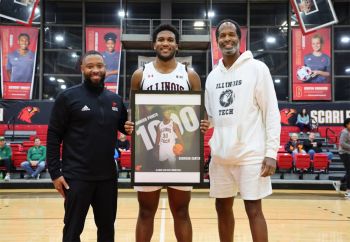Biomedical Engineering Students Build Electrocardiogram Kits in Remote, Online Laboratory

With the coronavirus pandemic limiting activity on campus as of mid-March, Armour College of Engineering biomedical engineering undergraduate students were determined to bring to life—virtually—the topics covered in BME 443 Biomedical Instrumentation and Electronics, led by Phil Troyk, professor of biomedical engineering and executive director of the Pritzker Institute of Biomedical Science and Engineering.
Sophia Nelson (BME 3rd Year) began to consider how students in the spring 2020 course could participate in hands-on learning experiences and continue to apply the principles of circuit analysis that was talked about in the virtual classroom. This idea sparked further discussions with Troyk about the possibility of developing a remote lab kit for students to build a circuit—and get it working—while sheltering in place at home. Chandrika Haldar (BME 3rd Year) and Claudio LoBraico (BME 4th Year) opted to participate in this remote lab opportunity along with Nelson.
Within a few days, the Pritzker Institute met this challenge by creating electrocardiogram laboratory kits remotely. An electrocardiogram, or ECG, is a test that measures the electrical activity of the heartbeat and can be used to diagnose and assess heart conditions. Finding out how long a wave takes to travel from one part of the heart to the next can show if the electrical activity is normal or slow, fast, or irregular.
Unlike other educational kits that are considered “plug and play,” Troyk explains that the Pritzker Institute’s lab kit required students to fabricate an electrocardiogram-measuring electronic circuit from individual components, debugging the circuit to obtain full operation.
To initiate the process, Troyk prepared a lab kit equipped with resistors and capacitors, electrodes to measure ECG results from the wrist, a solderless breadboard—a construction base for prototyping electronics—and portable oscilloscopes used to draw a graph of an electrical signal and create a waveform display.
“We didn’t just convert a laboratory, [Pritzker Institute] actually mailed the necessary hands-on materials to students at home,” says Troyk. “I put together a kit in which they could build their own heart monitor waveform just like we were discussing in the lecture.”
Troyk tackled the challenge of moving the course online by setting up Zoom meetings so that he could actively engage with students and provide feedback along the way. In addition, he provided detailed instructions and recorded videos to ensure each student had access to the necessary resources.
As a result, all three students successfully assembled the electrocardiogram circuit and produced heartbeat ECG waveforms, which they were able to measure and analyze from home.
Participating students then delivered a video presentation to the class in which they reported on the overall process and findings.
Nelson describes the electrocardiograph lab kit project as the highlight of the academic year. “Dr. Troyk provided us with the framework we needed such as his circuit implementation and testing notes…and most importantly our open minds,” she adds. “We also had the chance to design our own experiments, and it was very rewarding to see how an ECG can be alternatively designed to be an EEG, or a device that can measure if two hearts can beat as one.”
LoBraico shares that the ECG remote lab was his favorite academic experience as a college student. He chose to study biomedical engineering because of his interest in wearable technology and medical devices, and says that he could not pass up this opportunity.
“It had been a topic we spent several class periods on, discussing not only how the circuit is constructed and what components are used, but also the reasoning for why ECG amplifier circuits are built the way they are,” adds LoBraico. “Being able to apply this knowledge hands-on was invaluable. Plus, being able to reliably measure my own ECG with a device that I built at home was very rewarding.”
With some remote video troubleshooting assistance, students not only measured their own ECG waveforms but were also able to perform other experiments they designed themselves.
“One of the biggest takeaways was learning how to troubleshoot electronics without losing patience, which as a BME student with neural specialization is an invaluable skill,” says Haldar. “Personally, the satisfaction of being able to measure my own ECG with a tiny oscilloscope in my dorm room was beyond exciting, and I am thankful to Dr. Troyk for the chance as well as Sophia who came up with the idea.”
While students received nominal course credit, Troyk was impressed with the initiative they displayed throughout the process and the enthusiasm for more hands-on learning opportunities.
He shares that this collaborative experience goes beyond showcasing how Illinois Tech students and faculty came together to cope with a challenge; it highlights how they were able to create something better.
“When the last student sent the email after figuring it out, I said, ‘I’m so happy you got it.’ But then I looked at the ECG results and said, ‘Wow, your heart rate was 100. You must have been really excited, too,’ and she said that she was,” adds Troyk.
Photo: ECG measurement provided by Professor Phil Troyk




